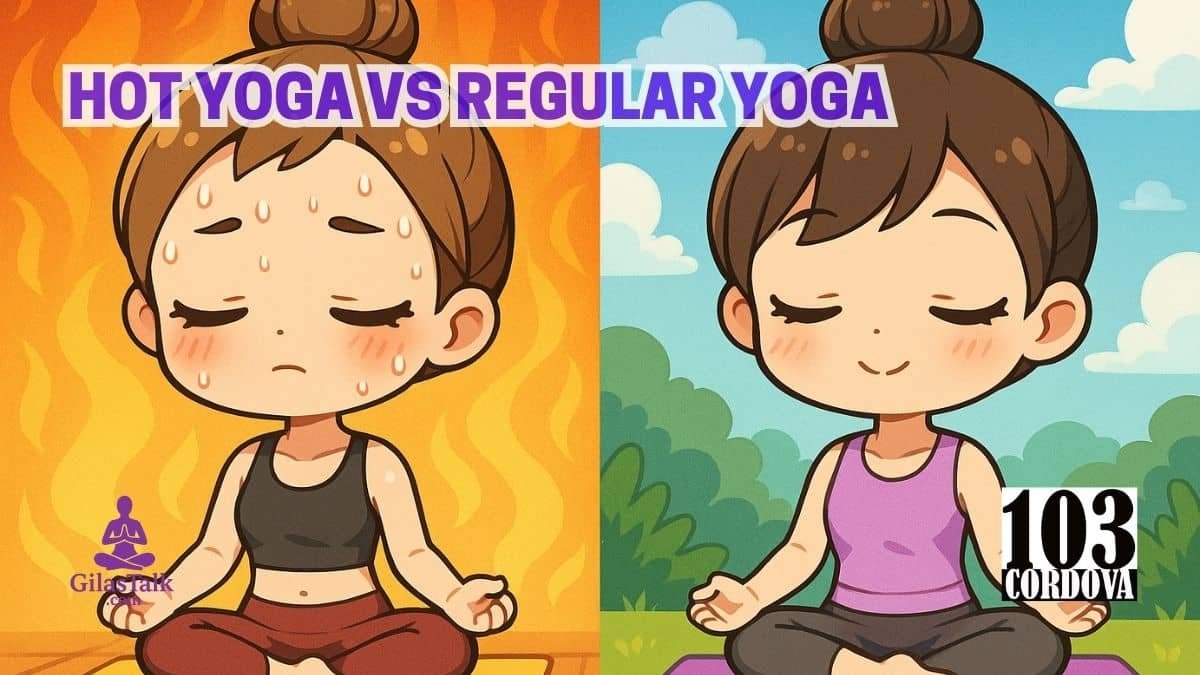When looking at hot yoga vs regular yoga, it helps to understand how the two practices differ in setting and intensity.
Hot yoga is done in a heated room, which makes the body work harder and can change how each pose feels.
Regular yoga is usually done at room temperature and focuses more on steady movement, balance, and mindful breathing.
Both styles bring unique physical and mental benefits, but the experience and demands are not the same.
We’ll compare the main differences so you can decide which practice is the better choice for your needs.
1. What’s the Difference Between Hot Yoga and Regular Yoga?
Hot yoga is done in a heated room where the temperature is usually between 32 and 40 °C, which makes the body sweat heavily and raises the heart rate.
One well-known form of hot yoga is Bikram Yoga, created by Bikram Choudhury, which uses a set sequence of 26 poses practiced in a room heated to 40 °C.
The heat makes muscles loosen faster, which can allow people to stretch more deeply and move with a wider range of motion.
This setting can also feel physically demanding because the body is working harder to stay balanced and comfortable in the poses.
Regular yoga, in contrast, is practiced at normal room temperatures and focuses on slow, steady posture, breathing, and alignment.
It draws on the principles of traditional yoga, which emphasizes not only physical poses but also mindfulness and inner awareness.
Many yoga studios today offer both hot yoga and regular yoga, giving people the chance to choose based on their comfort level and personal goals.
Hot yoga often appeals to those seeking an intense workout, while regular yoga is more supportive for long-term strength, stress relief, and relaxation.
The main difference between these practices is how the room temperature changes the physical challenge and the mental focus of the session.
🧘 Ashtanga Yoga Vs. Vinyasa Yoga: Key Differences and Benefits Explained
2. How Temperature Affects Your Yoga Practice
Temperature plays a major role in how the body responds during any style of yoga.
In hot yoga, the high heat combined with humidity creates conditions where muscles warm up quickly, making it easier to reach deeper stretches and improve flexibility.
The heated space can sometimes feel similar to being in a sauna, which can be energizing for some people but overwhelming for others.
Because of the intense heat, there is also a higher risk of dehydration, so bringing enough water and taking rest when needed are important steps for safety.
In contrast, regular yoga takes place in a comfortable room temperature where the body can move at a steady pace without extra stress from heat.
This controlled setting makes it easier to focus on alignment, posture, and mindful breathing without worrying about overheating.
Hot yoga often feels more physically demanding because sweat builds quickly and movements require more endurance.
Both hot and regular yoga offer valuable benefits, but the temperature of the room greatly changes the challenge and overall experience of the practice.
🧘 Why Chair Yoga Training Is Essential for Office Workers
3. Health Benefits: Hot Yoga vs. Regular Yoga
Both types of yoga offer a wide range of health benefits, but the effects vary depending on the style being practiced.
Hot yoga increases the heart rate in a heated space, which may improve circulation and provide measurable benefits for heart health.
The extra sweating during hot yoga can also help the body feel cleansed, but it requires careful attention to hydration.
Regular yoga, on the other hand, is especially useful for lowering stress levels, improving flexibility, and supporting long-term joint care.
It also encourages mindfulness through steady breathing, which helps maintain emotional balance and mental focus.
When comparing different types of yoga, it is clear that both hot and regular practices promote overall wellness, but they do so in unique ways.
🧘 Why Somatic Yoga Training is a Game Changer for Stress Relief
4. Impact on Different Body Types and Fitness Levels
Hot yoga often feels better for people who already have strong endurance, like athletes, because the heat pushes the body to work harder.
Seniors or those with limited mobility may find regular yoga more comfortable since it does not place extra stress on the heart or joints.
People who are new to exercise may also prefer starting with regular yoga before trying the heated environment.
Hot yoga can be challenging for individuals with certain health conditions, such as heart issues or dehydration risk.
Choosing between the two styles depends on your age, fitness level, and what feels safe and sustainable for your body.
🧘 Can Heated Vinyasa Yoga Help You Lose Weight Effectively?

5. Flexibility and Strength: Comparing the Two Practices
Hot yoga’s heated environment can allow muscles to stretch more deeply, which may accelerate flexibility gains.
The warmth encourages the body to move more freely, potentially increasing the range of motion faster than in regular yoga.
However, this can also lead to overstretching if you’re not careful, especially for those new to the practice.
Regular yoga, while slower in flexibility improvement, focuses more on alignment, building long-lasting strength, and avoiding injury through controlled movements.
Both practices build strength over time, but hot yoga may feel more intense due to the added heat.
🧘 How to Learn Aerial Yoga Poses Names for a Better Practice
6. Calorie Burn and Weight Loss: Which Yoga Style is More Effective?
Hot yoga generally burns more calories than regular yoga because of the higher temperature and increased heart rate.
A single session of hot yoga can burn anywhere from 400 to 500 calories, depending on the intensity, making it a popular choice for weight loss.
Regular yoga, while also effective for building strength and flexibility, typically burns fewer calories, around 200 to 300 per session, depending on the style.
Hot yoga’s combination of heat and intensity leads to more physical exertion, which in turn accelerates calorie burn.
If weight loss is a goal, hot yoga might offer faster results, but both practices contribute to overall fitness.
🧘 Exploring the Benefits of Meditation and Yoga
7. Mental and Emotional Benefits of Hot Yoga vs. Regular Yoga
Both hot yoga and regular yoga provide important mental benefits, but they approach them in different ways.
Regular yoga encourages mindfulness and relaxation, often using breathing exercises and meditation to calm the mind and reduce daily stress.
This slower pace allows practitioners to focus on emotional balance and steady mental clarity.
Hot yoga, in contrast, places the body in a heated and demanding setting that challenges focus and builds mental resilience.
Learning to stay calm in this environment can help improve concentration and strengthen the ability to handle stressful situations outside the studio.
While regular yoga may be better for easing anxiety, hot yoga can support mental toughness, and both practices promote a strong mind-body connection.
🧘 Surprising Benefits of Yoga for Health You Need to Know
8. Is Hot Yoga or Regular Yoga Better for Beginners?
For beginners, regular yoga is typically the more accessible option, as it involves a slower pace and lacks the added challenge of heat.
It allows new practitioners to learn poses and breathwork without the pressure of a hot room, which can feel overwhelming.
Hot yoga, though not impossible for beginners, can be physically demanding, and the heat adds an extra layer of difficulty.
Those new to yoga may find it easier to start with regular yoga and progress to hot yoga once they are more comfortable with the movements.
If you’re new to exercise or have certain health concerns, regular yoga might be a safer introduction to the practice.
🧘 How the Benefits of Daily Yoga Can Transform Your Life
9. Risks of Dehydration and Overheating in Hot Yoga
Hot yoga poses a significant risk of dehydration due to the high levels of sweating in a heated environment.
Practitioners are often advised to hydrate well before, during, and after sessions to avoid heat-related issues.
Overheating is another potential risk, especially for beginners or those with certain health conditions, as prolonged exposure to high temperatures can lead to dizziness, fatigue, or even heat exhaustion.
Regular yoga, practiced at normal room temperatures, does not carry the same risks, making it a safer option for those sensitive to heat.
Being mindful of hydration and knowing your physical limits is crucial in hot yoga to prevent these risks.
🧘 Why Bear Pose Yoga Is Essential for Building Core Strength and Stability
10. Cost and Accessibility: Hot Yoga vs. Regular Yoga
Hot yoga tends to be more expensive than regular yoga because it requires specialized heating systems, equipment, and studio maintenance.
Many hot yoga classes are only available at specific studios that cater to this type of practice, which can make it less accessible, especially in smaller towns or rural areas.
In contrast, regular yoga is more widely available, with classes offered at gyms, community centers, and even online.
The cost of a regular yoga class is generally lower, and many free or low-cost options are available for those looking to practice from home.
If cost and accessibility are concerns, regular yoga offers a more flexible and budget-friendly option.
🧘 The Holistic Benefits Of Ashtanga Yoga: Physical, Mental, and Beyond
11. Choosing the Right Yoga Practice Based on Your Goals and Preferences
When choosing between hot yoga and regular yoga, consider your personal fitness goals and comfort level.
If you’re aiming for intense calorie burn, faster flexibility gains, and enjoy the challenge of heat, hot yoga might be the better option.
However, if you’re looking for a practice that emphasizes relaxation and mindfulness or are new to yoga, regular yoga may suit you better.
It’s also important to factor in any health conditions or physical limitations that might make one practice more suitable than the other.
The best practice is the one that aligns with your needs and goals.
🧘 Understand Yoga More Clearly
💡 Conclusion
Both hot yoga and regular yoga offer unique advantages, and the right choice depends on your personal goals, preferences, and physical condition.
Hot yoga may be more effective for those looking for a high-intensity workout, rapid calorie burn, and increased flexibility, but it comes with additional risks, like dehydration.
Regular yoga, while less intense, is more accessible, emphasizes mindfulness, and offers steady physical improvement.
Each practice supports overall wellness, but the best fit depends on what you’re looking to achieve.
Trying both styles may help you determine which resonates most with you.
🧘 Our Services
Looking for yoga classes tailored to all ages?
Visit us at 103 Cordova Tower, Marquinton Residences, Sto. Nino, Marikina City, where we offer a variety of yoga practices to suit every skill level.
Whether you’re a beginner or an experienced yogi, our certified instructors will guide you through each session.
For more details or to book a class, reach out to us at 09176225780, through Facebook, or via our site’s contact form.
Join us to start your journey towards better health and wellness today!
❓ FAQs
1. What should I wear and bring to a hot yoga class compared to a regular one?
For a regular yoga class, comfortable, breathable clothing that allows for a full range of motion is sufficient.
You’ll typically only need your yoga mat and perhaps a water bottle.
For a hot yoga class, it’s best to wear minimal, moisture-wicking clothing (like shorts and a tank top or sports bra) as you will sweat a lot.
It is essential to bring a large water bottle, a yoga mat, and a highly absorbent towel to place over your mat to prevent slipping.
2. Are there any health conditions that make hot yoga a bad idea?
Yes, individuals with certain health conditions should be cautious or avoid hot yoga altogether.
These include cardiovascular issues like heart disease or low/high blood pressure, as the heat puts extra strain on the heart.
It’s also not recommended for pregnant women or those prone to dizziness or heatstroke.
If you have any pre-existing health concerns, it’s crucial to consult with your doctor before trying a hot yoga class.
3. Can I practice both hot and regular yoga? How should I balance them?
Absolutely!
Many people find that practicing both styles offers a well-rounded fitness routine.
You can use hot yoga on days you want a more intense, sweaty, and physically challenging workout.
On other days, you can practice regular yoga to focus on alignment, mindfulness, and gentle recovery.
For example, you might do two hot yoga sessions and one regular yoga session per week to balance intensity with restoration.
4. How should I prepare for my very first hot yoga class?
Preparation is key to having a safe and positive first experience.
A. Hydrate: Drink plenty of water throughout the day leading up to the class, not just right before.
B. Eat Lightly: Have a small, light snack about 2 hours before class, but avoid a heavy meal.
C. Arrive Early: Get to the studio early to acclimate to the heat and get set up without rushing.
D. Listen to Your Body: Don’t push yourself to keep up with experienced practitioners.
It is perfectly fine to rest in Child’s Pose if you feel dizzy or overwhelmed.
Your safety is the top priority.
5. I sweat a lot more in hot yoga. Does this mean I’m getting a better workout?
More sweat doesn’t automatically equal a better workout, but it does indicate that your body is working harder to cool itself down.
The elevated heart rate and increased effort required in a heated room generally lead to a higher calorie burn compared to a regular yoga session of the same duration.
However, the “best” workout depends on your goals.
Regular yoga may be “better” for building foundational strength with precise alignment, while hot yoga may be “better” for cardiovascular intensity and endurance.

